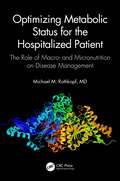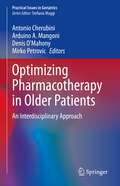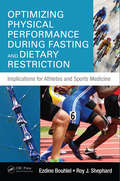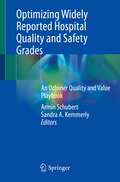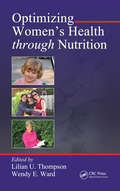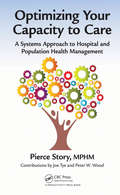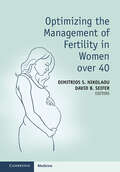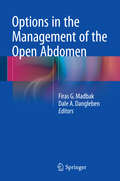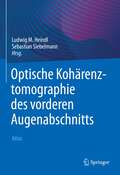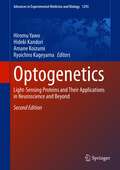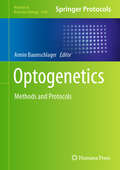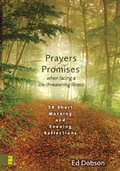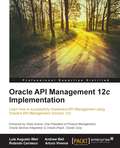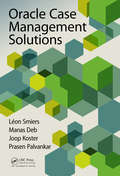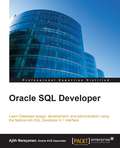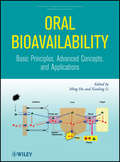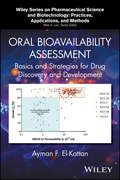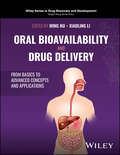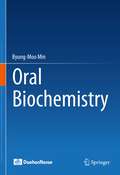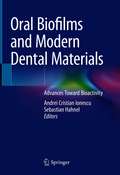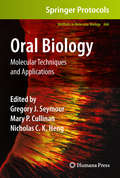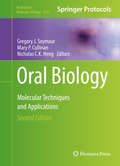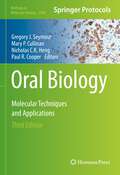- Table View
- List View
Optimizing Metabolic Status for the Hospitalized Patient: The Role of Macro- and Micronutrition on Disease Management
by Michael M. Rothkopf, MD, FACP, FACN Jennifer C. JohnsonThis book is a guide for clinicians seeking to use metabolic approaches in the care of hospitalized patients. Since a nutritional component exists for practically any disease process managed, it is important to properly address the macro- and micronutrient issues that can help facilitate a favourable clinical outcome. Metabolic medicine is a newly recognized speciality that applies proven nutritional approaches to support hospitalized patients within existing standards of care. Optimizing Metabolic Status for the Hospitalized Patient: The Role of Macro- and Micronutrition on Disease Management addresses the gap of nutrition knowledge among physicians who generally care for patients without addressing the nutritional and metabolic perspective. Features: · State-of-the-art guidelines for practicing metabolic medicine in the hospital setting. · “Hands on” guide for day-to-day metabolic management of hospitalized patients. · Personal insights from one of the field’s leading practitioners, drawing upon decades of experience. · Historical reviews of key scientific developments. This book is written by Dr Michael M. Rothkopf, Clinical Professor of Medicine at Rutgers/New Jersey Medical School. Dr Rothkopf founded the Metabolic Medicine Center at Morristown Medical Center and is the current Metabolic Medicine Consultant for the Heart Transplant, Lung Transplant, Cardiac Surgery and Wound Care Programs at RWJBH/Newark Beth Israel Medical Center. This book is directed at the physician level of hospital care. It provides value to a broad range of physicians regardless of their medical specialty or subspecialty. It will also be useful for medical students and resident physicians in training as well as nurse practitioners and physician assistants working in hospital settings.
Optimizing Pharmacotherapy in Older Patients: An Interdisciplinary Approach (Practical Issues in Geriatrics)
by Antonio Cherubini Arduino A. Mangoni Denis O’Mahony Mirko PetrovicThis book summarizes the broad and rapidly evolving field of geriatric pharmacotherapy, which is becoming increasingly relevant for practicing physicians who care and prescribe medications for older patients. Around the globe, ageing populations are associated with an increased prevalence of chronic diseases. Older adults are often affected by multimorbidity, i.e., suffer from more than one chronic disease. The main consequence of multimorbidity is polypharmacy, which is commonly defined as the regular use of five or more medicines. Polypharmacy has now reached epidemic proportions in our societies, and is associated with an increased risk of drug-drug interactions, drug-disease interactions and adverse drug reactions. The management of polypharmacy in older patients with complex multimorbidity poses several challenges and needs to be based on specific knowledge and prescribing expertise.The aim of this book is to provide a comprehensive update on the field, and to share the expertise needed to optimize the management of pharmacotherapy in older patients.
Optimizing Physical Performance During Fasting and Dietary Restriction: Implications for Athletes and Sports Medicine
by Roy J. Shephard Ezdine BouhlelOptimizing Physical Performance During Fasting and Dietary Restriction examines the effects of sustained fasting and food restrictions on metabolism and physical performance in athletes. It provides broad coverage including both religious and non-religious fasting and dietary restrictions.This practical and evidence-based guide outlines recent find
Optimizing Widely Reported Hospital Quality and Safety Grades: An Ochsner Quality and Value Playbook
by Armin Schubert Sandra A. KemmerlyThis practical, engaging book provides concise, real life-tested guidance to healthcare teams concerned with widely reported and incentivized hospital quality and safety metrics, offering both a conceptual approach and specific advice and frameworks for reviewing quality and safety numerator events, from the perspective and experience of clinicians and administrators working within the Ochsner Health System.The text opens with the rationale for closely managing widely (including publicly) reported hospital patient quality and safety measures. Attention is given to the financial implications of quality performance, with respect to both penalties and payment incentives used by payer organizations. It then reviews the major public ratings and their relevant methodologies, including CMS, AHRQ and NSHN. In addition, it addresses ratings by proprietary organizations that have a large member clientele, such as Vizient, USNews, Leapfrog, Healthgrades, CareChex and others. Each metric - for example, the AHRQ Patient Safety Indicators (PSIs), and other metrics such as readmission rate, risk adjusted complications, hospital-acquired conditions and mortality - is addressed in a stand-alone chapter. For each, the importance, approach to review, opportunity for optimization, and engagement of healthcare staff are reviewed and discussed. Overall, this book forefronts the benefits of a collaborative approach within a health system. The concurrent review process, multidisciplinary collaboration among quality improvement, clinical documentation, coding and medical staff personnel are all emphasized. Also described in detail is the approach to and specific opportunities for medical staff education and engagement. Additional key topics include Engagement of the Medical Staff and House Staff (i.e., residents and other trainees), Futile Care, Surgical Quality Improvement (NSQIP), Nursing Provider Partnership, and Translation of Data Review to Successful Performance Improvement. Specialty chapters on pediatric, neurologic and transplant quality metrics are also included.
Optimizing Women's Health through Nutrition
by Lilian U. Thompson Wendy E. WardIt is no surprise that women and men experience biological and physiological differences fundamentally and throughout the lifecycle. What is surprising is that faced with such a self-evident truth, there should be so little consideration to date of how these differences affect susceptibility to disease and metabolic response to dietary treatment. U
Optimizing Your Capacity to Care: A Systems Approach to Hospital and Population Health Management
by Pierce Story, MPHMOur nation's capacity to care is becoming increasingly stressed as an aging and increasingly unhealthy population collides with a relative reduction in the numbers of clinicians and ever-tightening financial resources. If even the mildest of future-state predictions are to be believed, we need a significant restructuring of our entire healthcare system and its total Capacity to Care, such that we can simultaneously improve care capacity, cost, quality, accessibility, and resource gratification.Optimizing Your Capacity to Care: A Systems Approach to Hospital and Population Health Management provides comprehensive guidance to a new way to optimize and manage community-wide Care Capacity via a unique, holistic approach to healthcare operations. Through clear examples and actual project results, the book demonstrates the outcomes of a systems-level way of thinking about a community's Capacity to Care that incorporates and integrates the full spectrum of available clinical and communal resources into the care of patients, including hospitals, physicians, emergency departments, surgical services, local churches, civic organizations, pharmacies, and volunteers.The book details operational models for each major department of the hospital and a fully integrated communal resource pool to demonstrate how the optimization of capacity, resource utilization, cost, and clinical outcomes can be attained. And by providing healthcare leaders with a deeper understanding of key elements missing from the most common process improvement methodologies and approaches, this book offers fresh perspectives and bold alternatives for hospitals, health systems, and entire communities.
Optimizing the Management of Fertility in Women over 40
by David B. Seifer Dimitrios S. NikolaouReproductive aging is a natural and universal process. Women frequently overestimate the age at which a significant decline in fertility occurs as well as overestimate the success of assisted reproductive technologies to circumvent age-related infertility. Yet there is much that modern medicine can do to improve conception rates in women who delay childbearing and to manage subsequent pregnancies. This book offers guidance on winning strategies for maximizing the live-birth rate and limiting the risk for women trying to conceive later in life. It is intended to assist in navigating this challenging journey and lead to peace of mind that women have been seen, heard, and treated as individuals in the process. Written by leading experts addressing medical options of applying advanced reproductive technologies, psychological, nutritional, lifestyle, systematic approaches to optimizing fertility care for the most challenging demographic of women in a practical, clinically orientated, and most importantly, positive way.
Options in the Management of the Open Abdomen
by Firas G. Madbak Dale A. DanglebenThis book by Madbak and Dangleben has collated lot of information that has been presented and published in many disparate arenas into a single easy to read source. In an area where there is more experience and "favorite techniques" than true evidence based answers, they provide a wealth of information along with outstanding photographic support that makes this an excellent resource for all surgeons caring for this population. Similar to many things in life, when treating patients with the open abdomen one size or methodology does not fit all and this book will assuredly contain at least one possible answer to your patient's problem. Although the numbers of "open abdomens" are decreasing due to changes in resuscitation and transfusion practices, it still represents a complex complication that can be challenging to deal with. This ambitious textbook on the management of the open abdomen provides a practical approach for addressing this complex problem. One of the more unique aspects of this textbook is its detailed "How to" approach for the wide variety of techniques utilized in the management of the open abdomen. While there may be no consensus as to what constitutes the optimal management of the open abdomen, this book articulates a number of options and their advantages. Most importantly, it provides high quality photographs that enhance the step by step "How to" approach of the text. More recent developments including using biologic mesh, implementing complex abdominal wall reconstruction and utilizing minimally invasive endoscopic techniques are described. This book is not only appropriate for all practicing surgeons that deal with this complex issue, but is also relevant for residents and fellows who are just getting their first exposure to open abdomens.
Optische Kohärenztomographie des vorderen Augenabschnitts: Atlas
by Ludwig M. Heindl Sebastian SiebelmannErster Atlas zur Vorderabschnitts-OCT mit über 500 TeilabbildungenAls schmerzfreies bildgebendes Verfahren hat die optische Kohärenztomographie (OCT) ihren festen Platz in der Früherkennung, Diagnostik und Verlaufskontrolle von Augenerkrankungen. OCT-Befunde können mit ihren hochaufgelösten Bildern wichtige Informationen bei der Diagnose von Erkrankungen der Hornhaut, Iris, Linse und der vorderen Augenkammer geben. Der Atlas trägt als einzigartige Sammlung zur Optischen Kohärenztomographie (OCT) für den vorderen Augenabschnitt zahlreiche Abbildungen seltener und häufiger Diagnosen zusammen. Die Expertise des Autorenteams fließt in die Interpretation der zahlreichen OCT-Befunde ein und erstellt somit ein wertvolles Nachschlagewerk für jede Augenärztin und jeden Augenarzt.
Optogenetics: Light-Sensing Proteins and Their Applications in Neuroscience and Beyond (Advances in Experimental Medicine and Biology #1293)
by Ryoichiro Kageyama Hiromu Yawo Hideki Kandori Amane KoizumiThis book, now in a thoroughly revised second edition, offers a comprehensive review of the rapidly growing field of optogenetics, in which light-sensing proteins are genetically engineered into cells in order to acquire information on cellular physiology in optical form or to enable control of specific network in the brain upon activation by light. Light-sensing proteins of various living organisms are now available to be exogenously expressed in neurons and other target cells both in vivo and in vitro. Cellular functions can thus be manipulated or probed by light. The new edition documents fully the extensive progress since publication of the first edition to provide an up-to-date overview of the physical, chemical, and biological properties of light-sensing proteins and their application in biological systems, particularly in neuroscience but also in medicine and the optical sciences. Underlying principles are explained and detailed information provided on a wide range of optogenetic tools for the observation and control of cellular signaling and physiology, gene targeting technologies, and optical methods for biological applications. In presenting the current status of optogenetics and emerging directions, this milestone publication will be a “must read” for all involved in research in any way related to optogenetics.
Optogenetics: Methods and Protocols (Methods in Molecular Biology #2840)
by Armin BaumschlagerThis volume explores the latest advancements in the field of optogenetics and how it uses cellular light-sensing components and genetic engineering to control proteins and biological processes. The book chapters are organized into four parts. Part One focuses on intracellular optogenetic components for control of specific cell functions; Part Two looks at externally supplied light regulators that do not require genetic manipulation of target cells; Part Three highlights optogenetic control of organelles, and Part Four introduces technical tools required for light induction in optogenetic experiments, as well as a method for performing and analyzing optogenetic cell-cell adhesion. Written in the highly successful Methods in Molecular Biology series format, chapters include introductions to their respective topics, lists of the necessary materials and reagents, step-by-step, readily reproducible laboratory protocols, and tips on troubleshooting and avoiding known pitfalls. Cutting-edge and practical, Optogenetics: Methods and Protocols is a valuable resource to help researchers understand and apply the concepts of optogenetics and the underlying bioengineering principles, and establish the required technical light-illumination setups for administering light inputs and analysis of experimental outcomes.
Opvoeden met gezond verstand
by J. VerhulstHoe je je kind opvoedt en of je een positieve sfeer weet te creëren, hangt niet alleen af van wat je doet, maar vooral van hoe je denkt. In Opvoeden met gezond verstand laat de bekende psycholoog Jan Verhulst zien, hoe je met een andere manier van denken de opvoeding heel wat lichter en effectiever kan maken. Gedachten heb je niet alleen bewust, maar ook onbewust. Onderzoek je de gedachten die jouw handelen bij het opvoeden beinvloeden, dan blijkt dat deze bij veel mensen niet zo reëel zijn. Zo kun je bijvoorbeeld diep van binnen denken dat je kind altijd naar je moet luisteren, of dat jij altijd de oplossing voor problemen moet hebben, maar is dat reëel? Door je bewust te worden van de impliciete verwachtingen en gedachten die je hebt en deze te vervangen door reële gedachten en haalbare doelen, haal je veel spanning uit de opvoeding. Dit boek laat je stap voor stap zien hoe je in verschillende situaties volgens de principes van de bekende RET methode (Rationeel Emotieve Therapie) verwachtingen en gedachten positief kunt sturen. Een belangrijk hulpmiddel hierbij is de in het boek opgenomen RET-test, waarmee je kunt vaststellen waar jouw grootste valkuilen liggen. Het boek biedt voorbeelden en oplossingen voor alle leeftijden en gezinssamenstellingen. Van huilbaby tot onverschillige puber, van eetprobleem tot gameverslaving. De vele voorbeelden en praktische tips roepen herkenning op, bieden je een spiegel en helpen je de meest uiteenlopende opvoedproblemen en valkuilen het hoofd te bieden. Positief en met zelfvertrouwen!
Oraciones y Promesas
by Edward G. DobsonSPANISH EDITION: Thirty short, yet powerful morning and evening reflections offer encouragement, hope, and inspiration to people dealing with a life-threatening illness, as well as their family members and caretakers. Here are honest insights and personal stories from a pastor who continues his own journey with ALS (Lou Gehrig's disease).
Oracle API Management 12c Implementation
by Andrew Bell Luis Augusto WeirLearn how to successfully implement API management using Oracle's API Management Solution 12c About This Book * Explore the key concepts, goals, and objectives of API Management and learn how to implement it using the Oracle API Management Solution * Understand the concepts and objectives of the Application Service Governance (ASG), along with the governance framework that encompasses people, processes, and technology * Get to grips with API Management readiness assessments, gap analysis, digital reference architecture, and implementation roadmaps Who This Book Is For This book is for Enterprise Architects, Solution Architects, Technical Architects, and SOA and API consultants who want to successfully implement API Management using the Oracle API Management Solution products. What You Will Learn * Understand how to manage a set of APIs * Discover the differences and similarities between API Management and SOA Governance, and where and how these two disciplines converge into Application Services Governance (ASG) * Grasp information about ASG and how to define an ASG governance framework * Understand the challenges for organizations looking to expose APIs to the external world. Identify common scenarios and how to solve them * Define an Oracle API management deployment topology * Install and configure Oracle API Catalog (OAC), Oracle API Manager (OAPIM), and Oracle API Gateway (OAG) * Learn about API subscriptions and API community management with the OAPIM portal * Implement Oracle API Manager (OAPIM) including creation, publishing, management and deprecation of APIs In Detail Oracle SOA Governance is a comprehensive, service-orientated governance solution that is designed to make the transition to SOA easier. API management is the discipline that governs the software development lifecycle of APIs. It defines the tools and processes needed to build, publish and operate APIs including the management of the community of developers around it. This book illustrates how to successfully implement API Management in your organization. To achieve this, the importance of defining an API management strategy and implementation roadmap so that capabilities are implemented in the right order and timeframes is described. It starts by describing all of the fundamental concepts around API Management and related disciplines such as SOA Governance and DevOps in order to dispel the confusion surrounding these topics. The book then takes you on the journey of implementing API Management, using a realistic case study of an organization that needs an API Management solution. You will start by identifying the key business drivers to implement APIs and then create an API Management strategy and a roadmap to realize this strategy. You'll then go through a number of use cases, each focused on addressing specific business requirements. These will help you understand each of the Oracle API Management products, how they fit into an overall architecture, and how to implement them. The book concludes by providing some tips and guidelines around defining a deployment topology for the Oracle API Management products and the steps to install them. Style and approach This book is a comprehensive guide to successfully implementing a complete API Management solution from inception to implementation. The initial chapters introduce you to Oracle SOA Governance and API Management and from there, chapters are mainly hands-on and provide a full step-by-step walkthrough of how to implement the products of the Oracle API management solution to address realistic use cases.
Oracle Case Management Solutions
by Manas Deb Prasen Palvankar Leon Smiers Joop KosterOrganizations increasingly need to deal with unstructured processes that traditional business process management (BPM) suites are not designed to deal with. High-risk, yet high-value, loan origination or credit approvals, police investigations, and healthcare patient treatment are just a few examples of areas where a level of uncertainty makes outc
Oracle SQL Developer
by Ajith NarayananLearn Database design, development,and administration using the feature-rich SQL Developer 4.1 interface About This Book * Explore all the SQL Developer 4.1 features useful for Oracle database developers, architects, and administrators * Understand how this free tool from Oracle has evolved over the years and has become a complete tool that makes life easy for Oracle and third-party database users * The author, Ajith Narayanan, has a total of 10+ years of work experience as an Oracle [APPS] DBA Who This Book Is For This book is intended for Oracle developers who are responsible for database management. You are expected to have programming knowledge of SQL and PL/SQL, and must be familiar with basic Oracle database concepts. What You Will Learn * Install and navigate through all the advanced features of SQL Developer that were introduced in version 4.1 * Browse, create, edit, and delete (drop) database objects * Use the SQL worksheet to run SQL statements and scripts, edit and debug PL/SQL code, manipulate and export (unload) data * Carry out all DBA-related activities such as exporting/importing, tuning, and analyzing database performance issues * Quickly analyze, create, and edit the data model using data modeler * Extend the SQL developer capabilities by exploring the APEX related pages, enabling and working with RESTful services * Use the available reports and create new custom reports with custom scripts * Grasp how to connect to third-party databases and work smoothly with them In Detail At times, DBAs support 100s of databases at work. In such scenarios, using a command-line tool like putty adds to the difficulty, while SQL Developer makes the life of a developer, DBA, or DB architect easier by providing a graphical user interface equipped with features that can bolster and enhance the user experience and boost efficiency. Features such as DBA panel, Reports, Data Modeler, and Data Miner are just a few examples of its rich features, and its support for APEX, REST Services, timesten, and third-party database drivers demonstrate its extensibility. You may be a newbie to databases or a seasoned database expert, either way this book will help you understand the database structure and the different types of objects that organize enterprise data in an efficient manner. This book introduces the features of the SQL Developer 4.1 tool in an incremental fashion, starting with installing them, making the database connections, and using the different panels. By sequentially walking through the steps in each chapter, you will quickly master SQL Developer 4.1. Style and approach This book follows a step-by-step approach and is in a conversational and easy-to-follow style. Screenshots , and detailed explanations of the basic and advanced features of SQL Developer 4.1 that will make your work and life easy.
Oral Bioavailability
by Ming Hu Xiaoling LiUnderstand and assess the design, delivery, and efficacy of orally administered drugs A practical guide to understanding oral bioavailability, one of the major hurdles in drug development and delivery, Oral Bioavailability: Basic Principles, Advanced Concepts, and Applications is designed to help chemists, biologists, life science researchers, pharmaceutical scientists, pharmacologists, clinicians, and graduate and students become familiar with the fundamentals and practices of the science of oral bioavailability. The difference in rate and extent between a drug taken orally and the actual amount of a drug reaching the circulatory system, oral bioavailability is an essential parameter for determining the efficacy and adverse effects of new and developing medications, as well as finding an optimal dosing regimen. This book provides a much-needed one-stop resource to help readers better understand and appreciate the many facets and complex problems of oral bioavailability, including the basic barriers to oral bioavailability, the methods used to determine relevant parameters, and the challenges of drug delivery. In addition, this comprehensive book discusses biological and physicochemical methods for improving bioavailability, integrates physicochemistry with physiology and molecular biology, and includes several state-of-the-art technologies and approaches-Caco-2 cell culture model, MDCK, and other related cell culture models-which are used to study the science of oral bioavailability.
Oral Bioavailability Assessment: Basics and Strategies for Drug Discovery and Development
by Mike S. Lee Ayman F. El-KattanSpecifically geared to personnel in the pharmaceutical and biotechnology industries, this book describes the basics and challenges of oral bioavailability – one of the most significant hurdles in drug discovery and development.• Describes approaches to assess pharmacokinetics and how drug efflux and uptake transporters impact oral bioavailability• Helps readers reduce the failure rate of drug candidates when transitioning from the bench to the clinic during development• Explains how preclinical animal models – used in preclinical testing – and in vitro tools translate to humans, which is an underappreciated and complicated area of drug development• Includes chapters about pharmacokinetic modelling, the Biopharmaceutics Drug Disposition Classification System (BDDCS), and the Extended Clearance Classification System (ECCS)• Has tutorials for applying strategies to medicinal chemistry practices of drug discovery/development
Oral Bioavailability and Drug Delivery: From Basics to Advanced Concepts and Applications (Wiley Series in Drug Discovery and Development)
by Ming Hu Xiaoling LiORAL BIOAVAILABILITY AND DRUG DELIVERY Improve the performance and viability of newly-developed and approved drugs with this crucial guide Bioavailability is the parameter which measures the rate and extent to which a drug reaches a user’s circulatory system depending on the method of administration. For example, intravenous administration produces a bioavailability of 100%, since the drugs are injected directly into the circulatory system; in the case of oral administration, however, bioavailability can vary widely based on factors which, if not properly understood, can result in a failure in drug development, adverse effects, and other complications. The mechanics of oral bioavailability are therefore critical aspects of drug development. Oral Bioavailability and Drug Delivery provides a comprehensive coverage of this subject as well as its drug development applications. Beginning with basic terminology and fundamental concepts, it provides a thorough understanding of the challenges and barriers to oral bioavailability as well as the possibilities for improving this parameter. The resulting book is an indispensable tool for drug development research. Oral Bioavailability and Drug Delivery readers will also find: Discussion questions in many chapters to facilitate comprehension Detailed discussion of topics including dissolution, absorption, metabolism, and more Real-world examples of methods in actions throughout Oral Bioavailability and Drug Delivery is ideal for pharmaceutical and biotechnology scientists working in drug discovery and development; researchers in chemistry, biology, pharmacology, immunology, neuroscience, and other related fields; and graduate courses in drug development and delivery.
Oral Biochemistry
by Byung-Moo MinThis book provides the reader with a comprehensive understanding of oral biochemistry by explaining the role of basic biochemistry and dentistry concepts and identifying their metabolic processes of soft tissues that comprise oral and maxillofacial anatomy. The book also discusses how metabolic abnormalities are related to the development of oral diseases. Readers will gain a comprehensive perspective on a variety of oral conditions and related metabolic abnormalities. Individual chapters are focused on crucial topics such as enamel, dentine, saliva, fluoride, and many more. The importance of evidence-based explanation and case study details are also highlighted. Oral biochemistry is the first book to be devoted entirely to this area, and it will be of interest to researchers, students, and practitioners.
Oral Biofilms and Modern Dental Materials: Advances Toward Bioactivity
by Andrei Cristian Ionescu Sebastian HahnelThis book provides an up-to-date perspective on oral biofilms and dental materials, equipping readers with a sound understanding of their mutual interactions. Experts from across the world comprehensively describe the main strategies that can be followed when designing modern bioactive and biomimetic dental materials, bearing in mind the goal of reducing the occurrence of pathological conditions such as secondary caries and peri-implantitis. The background to the book is the rapid expansion in the use of nanotechnologies and modern techniques to achieve levels of performance of dental materials that were unthinkable even a few years ago. Whereas conventionally dental materials have been regarded as inert, an important paradigm shift is underway: now, these materials are being conceived as bioactive and biomimetic. Modern dental materials can produce a response by interacting positively both with the host and with the biofilm permanently colonizing hard and soft tissues of the oral cavity. These materials increasingly mimic the behavior of the tissues that they are replacing. In documenting the latest knowledge in the field, this book will be of value for both scientists in the fields of nanotechnology, biofilms and dental materials and interested clinicians.
Oral Biofilms in Health and Disease (Springer Series on Biofilms #14)
by Hyun Michel Koo Nicholas S. Jakubovics Bastiaan P. KromThis book presents state-of-the-art information on the fundamentals of oral biofilm formation. The reader learns about adhesion and early colonization of polymicrobial communities, the biochemistry and function of the oral biofilm matrix, cooperative interactions, as well as antagonism among microbes within oral biofilms. The past decade has brought major technological advancements in molecular and microscopy technologies changing our understanding of oral biofilms in health and disease. International experts comprehensively describe key strategies and techniques for studying oral biofilms in vitro, ex vivo and in vivo, including imaging, model systems and omics approaches. In addition, the book provides an up-to-date overview of oral biofilms and associated diseases. Innovative antibiofilm strategies are also addressed. These span from eradication or modulation of oral biofilms as a prevention strategy, and nonantibiotic or antibiotic-supplementing approaches such as quorum sensing inhibition, nanoparticles and pre-and probiotics. The book is a useful introduction to the field for early career scientists interested in basic and translational research on oral biofilms. It is also an interesting read for advanced scientists and clinicians working in dentistry and oral health research, as it gives them a broader view of the topic beyond their area of specialization.
Oral Biology
by Mary P. Cullinan Gregory J. Seymour Nicholas C.K. HengWith so many major advances over the past two decades coming through the application of molecular biology and nanotechnology, it is essential that dental research, education, and practice keep pace with the rapid progress of science. In Oral Biology: Molecular Techniques and Applications, expert researchers in the field have provided a selection of in depth methods and techniques optimized for particular applications, which can be readily adapted to particular organisms or areas of interest. Divided into three convenient sections, the book covers the study of saliva, as it is a rich source of biomolecules for study at the molecular level, which may lead to the identification of susceptibility to particular diseases, the study of the microbial inhabitants that share the oral cavity with us, as well as a range of protocols that facilitate assessment of the molecular behavior of oral cells and tissues in health and during disease progression. Written in the highly successful Methods in Molecular BiologyTM series format, chapters include introductions to their respective topics, lists of the necessary materials and reagents, step-by-step, reproducible laboratory protocols, and tips on troubleshooting and avoiding known pitfalls. Authoritative and cutting-edge, Oral Biology: Molecular Techniques and Applications is an ideal resource not only to the new researcher but also to the seasoned laboratory veteran including cell biologists, microbiologists, and any researchers intent on delving into the vital world of oral biology.
Oral Biology
by Mary P. Cullinan Gregory J. Seymour Nicholas C.K. HengThis second edition volume presents a selection of cellular and molecular techniques that can be adapted to cover a range of applications and diseases. The book is divided into three sections: saliva and oral diseases, molecular biosciences, and cell and tissues. The first section contains chapters that discuss proteomic analyses by mass spectrometry and NMR-based metabolomics that can be used to not only study saliva, but also to assess other oral fluids such as gingival crevicular fluid. The second section contains chapters that profile oral microbial communities, quantitative real-time PCR, and adhesion of yeast and bacteria to oral surfaces. The third section deals with a range of approaches that enable the behavior of cells and tissues in both health and disease to be analyzed at the molecular level. Written in the highly successful Methods in Molecular Biology series format, chapters include introductions to their respective topics, lists of the necessary materials and reagents, step-by-step, readily reproducible laboratory protocols, and tips on troubleshooting and avoiding known pitfalls. Cutting-edge and comprehensive, Oral Biology: Molecular Techniques and Applications, Second Edition is a useful resource for oral biologists at all levels (students, early career researchers, and experienced veterans), and it provides a ready reference to new techniques and approaches that can be used to answer numerous specific scientific questions that may lead to a deeper understanding and treatments of oral diseases.
Oral Biology: Molecular Techniques and Applications (Methods in Molecular Biology #2588)
by Mary P. Cullinan Gregory J. Seymour Nicholas C. K. Heng Paul R. CooperThis fully revised new edition explores advances in the prevention and treatment of oral diseases. Beyond the updated chapters, the book delves into regenerative biology, gene editing and the use of CRISPR in oral biology, as well as histone acetylation and deacetylation methods, further reflecting advances in the application of molecular techniques to oral biology. Written for the highly successful Methods in Molecular Biology series, chapters include introductions to their respective topics, lists of the necessary materials and reagents, step-by-step and readily reproducible laboratory protocols, and tips on troubleshooting and avoiding known pitfalls. Authoritative and up-to-date, Oral Biology: Molecular Techniques and Applications, Third Edition serves as an ideal basic resource not only for new researchers but also for experienced scientists wishing to expand their research platform into new areas of this vital field.
